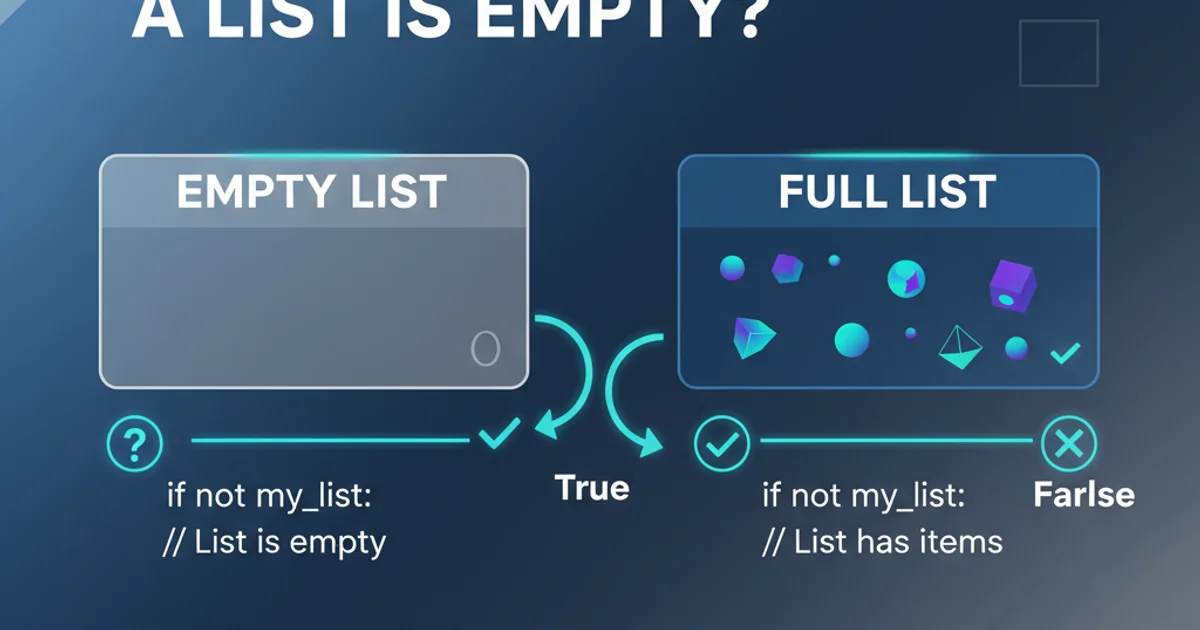How do I check if a list is empty?
Categories:
How to Check if a Python List is Empty

Learn the most effective and Pythonic ways to determine if a list is empty, understanding the nuances and performance implications of each method.
Checking if a list is empty is a fundamental operation in Python programming. Whether you're processing user input, handling data from an API, or iterating through collections, knowing how to reliably determine if a list contains any elements is crucial for preventing errors and writing robust code. This article explores several common methods, highlighting their Pythonic nature and practical applications.
The Pythonic Way: Implicit Boolean Conversion
In Python, many built-in data structures, including lists, have an inherent boolean value. An empty list evaluates to False in a boolean context, while a non-empty list evaluates to True. This characteristic allows for a very concise and readable way to check for emptiness, often considered the most Pythonic approach.
my_list = []
if not my_list:
print("The list is empty.")
else:
print("The list is not empty.")
# Example with a non-empty list
another_list = [1, 2, 3]
if another_list:
print("Another list is not empty.")
else:
print("Another list is empty.")
Using implicit boolean conversion to check for an empty list.
Using the len() Function
Another straightforward method is to use the built-in len() function, which returns the number of items in an object. For a list, len() will return 0 if it's empty. You can then compare this value to 0.
my_list = []
if len(my_list) == 0:
print("The list is empty.")
else:
print("The list is not empty.")
# Example with a non-empty list
another_list = ['a', 'b']
if len(another_list) > 0:
print("Another list is not empty.")
else:
print("Another list is empty.")
Checking for an empty list using the len() function.
len(my_list) == 0 is functionally equivalent to not my_list, the latter is often considered more idiomatic Python. Both are efficient for lists.Comparing to an Empty List Literal
You can also directly compare a list to an empty list literal []. This method explicitly checks if the list is identical to an empty list. While it works, it's generally less preferred than the boolean conversion or len() methods.
my_list = []
if my_list == []:
print("The list is empty.")
else:
print("The list is not empty.")
# Example with a non-empty list
another_list = [None]
if another_list != []:
print("Another list is not empty.")
else:
print("Another list is empty.")
Comparing a list to an empty list literal.
len() because it involves an actual comparison operation rather than a simple boolean evaluation. It's also less readable for experienced Python developers.Choosing the Right Method
The choice of method often comes down to readability and Pythonic style. The implicit boolean conversion (if not my_list:) is widely regarded as the most Pythonic and efficient way to check for an empty list. The len() function is also perfectly acceptable and sometimes preferred for clarity when the count of elements is also relevant. Direct comparison with [] is functional but generally discouraged.
flowchart TD
A[Start] --> B{Is list 'my_list' empty?}
B -- "Pythonic (not my_list)" --> C{my_list evaluates to False?}
C -- Yes --> D[List is empty]
C -- No --> E[List is not empty]
B -- "Using len()" --> F{len(my_list) == 0?}
F -- Yes --> D
F -- No --> E
B -- "Comparing to []" --> G{my_list == []?}
G -- Yes --> D
G -- No --> EDecision flow for checking if a Python list is empty.
Understanding these methods will help you write cleaner, more efficient, and more Pythonic code when dealing with list emptiness checks.